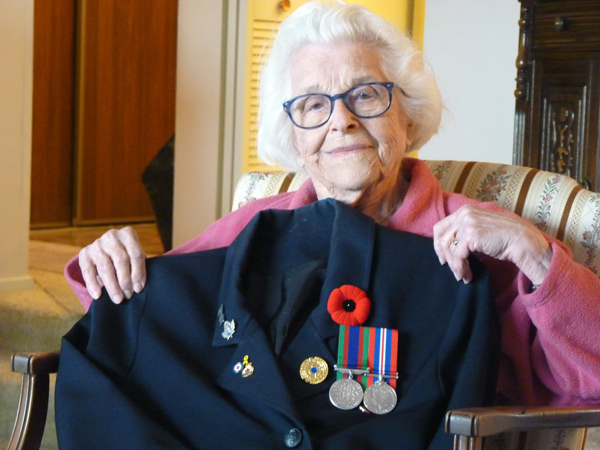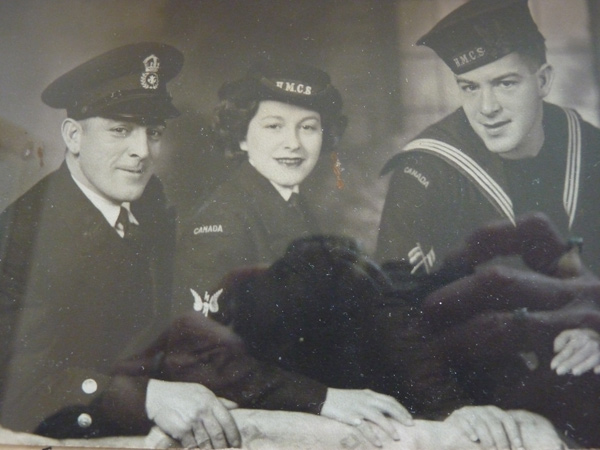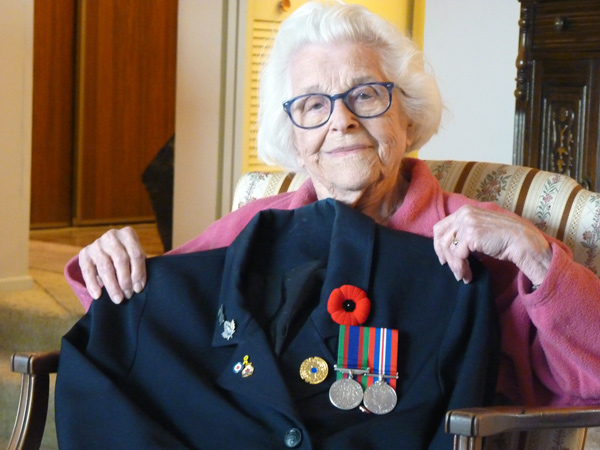By Judith van Berkom –
At 94, Elsa Lessard is an energetic, lively woman, with a keen mind, a good memory, who speaks at schools, Rotary Clubs, and The Legion, about her World War II experiences as one of 7,000 women who joined the Navy, a group known as the WRENS (the Women’s Royal Canadian Naval Service).

Elsa Lessard’s older brother, Frank, joined the Navy much earlier on and had taught her Morse code as a young child. Elsa’s younger brother, Ossie, also joined the Navy and worked in Morse code, but with flags.
A graduate of Lisgar Collegiate, the federal government recruited Elsa and many young women who could read and write from across Canada to keep records in 1940.
When Navy recruiters came to Ottawa in 1942, Elsa was already in charge of a whole section of the federal finance department, responsible for sending allotments to dependents and families of soldiers serving in the war.
“I took an oath of secrecy, which is a burden,” she explains. “You couldn’t work on personal files unless you agreed not to divulge anything. In my 90s, I find it a big burden. I know things about people – it’s very difficult.”
“In August 1942, the Dieppe raid took place [in France] and our troops were massacred. I remember it; I was 20 years old. The cheques allotted to mothers and dependents – we had to hold them all and pull out the names of those missing. How sensitive our government was, not to just deliver cheques to these families of missing soldiers. It was delivered in a special manner. I remember how affected I was by the Dieppe raid.”
Years later, Elsa read the notes from her Navy interview. The interviewer had written: “She wants to be a wireless telegrapher like her brother. However, she has experience in fields where she may be more useful. But she should be offered the course.”

During her first summer as a Navy recruit, Elsa took a six-week course in Morse code and became a ‘listener.’ Seven hundred WRENS were placed in farmers’ fields where the public couldn’t see the antennas needed to intercept enemy messages.
Elsa started her career as a listener in Leitrim and was transferred in March 1943 to Coverdale, New Brunswick, to the property of a pig farmer on a hill where the reception was far superior. Messages were intercepted 24-hours-a-day.
“Whenever a submarine wanted to contact German headquarters, it had to surface. That’s when you could take a bearing on where they were. When we heard this we hit a panic button and yelled in the frequency. A gal about a kilometre away in a shack in a farmer’s field took the bearing. That’s how we tracked U-boats during the war,” describes Elsa.
“The worst was the graveyard shift, about four in the morning,” she says. “The rest of the time wasn’t all serious. We didn’t know what we were doing. The townspeople were really nice to us; Canadians are really nice,” she adds.
After the war, Elsa became an electronics technician and got a job in a wholesale business, becoming the purchasing agent of electronic parts.
“When I retired in 1983, I had so many interests, I never stopped.” One of her hobbies was researching the genealogy of both her parents.
Elsa is a very private person. She doesn’t talk about her personal life and doesn’t want to be defined by whose wife she may or may not be, or how many children she has or has not had. She does, however, continue to live independently in her current apartment where she has been for the last 41 years.
For information about local Remembrance Day ceremonies, see the community calendar.
